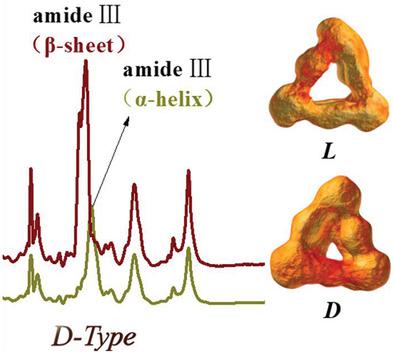当前位置:
X-MOL 学术
›
Adv. Mater.
›
论文详情
Our official English website, www.x-mol.net, welcomes your
feedback! (Note: you will need to create a separate account there.)
Chiral Plasmonic Triangular Nanorings with SERS Activity for Ultrasensitive Detection of Amyloid Proteins in Alzheimer's Disease
Advanced Materials ( IF 27.4 ) Pub Date : 2021-07-26 , DOI: 10.1002/adma.202102337 Gaoyang Wang 1 , Changlong Hao 1 , Wei Ma 1 , Aihua Qu 1 , Chen Chen 1 , Jun Xu 2 , Chuanlai Xu 1 , Hua Kuang 1 , Liguang Xu 1
Advanced Materials ( IF 27.4 ) Pub Date : 2021-07-26 , DOI: 10.1002/adma.202102337 Gaoyang Wang 1 , Changlong Hao 1 , Wei Ma 1 , Aihua Qu 1 , Chen Chen 1 , Jun Xu 2 , Chuanlai Xu 1 , Hua Kuang 1 , Liguang Xu 1
Affiliation

|
Chiral plasmonic nanomaterials have attracted unprecedented attention due to their broad applications in biomedicine, negative refractive index, and chiral sensing. Here, using a wet-chemistry process, chiral triangular Au nanorings are fabricated with a platinum (Pt) framework (l/d-Pt@Au triangular nanorings, named l/d-Pt@Au TNRs). The l/d-Pt@Au TNRs exhibit strong optical activity with a g-factor of 0.023 and can be used effectively for the discrimination of enantiomers due to selective resonance coupling between the induced electric and magnetic dipoles associated with enantiomers and the chiral plasmonic TNRs, also known as the surface-enhanced Raman scattering-chiral anisotropy (SERS-ChA) effect. The chiral d-Pt@Au TNRs represent a label-free SERS platform that can be applied to detect Aβ monomers and fibrils, the hallmarks of Alzheimer's disease (AD), achieving a limit of detection (LOD) down to 0.045 × 10−12 m and 4 × 10−15 m for 42-residue-long amyloid-β (Aβ42) monomer and fibrils, respectively. Furthermore, chiral d-Pt@Au TNRs can also be successfully carried out to detect Aβ42 proteins in AD patients with ultrahigh levels of sensitivity, thus allowing picogram quantities of Aβ42 proteins to be identified. This research opens up an avenue for the use of chiral plasmonic nanomaterials as ultrasensitive SERS substrates to early diagnosis of protein-misfolding diseases.
中文翻译:

具有 SERS 活性的手性等离子体三角纳米环用于阿尔茨海默病中淀粉样蛋白的超灵敏检测
手性等离子体纳米材料由于其在生物医学、负折射率和手性传感方面的广泛应用而引起了前所未有的关注。在这里,使用湿化学工艺,用铂(Pt)骨架制备了手性三角形Au纳米环( l / d -Pt@Au三角形纳米环,命名为l / d -Pt@Au TNR)。 l / d -Pt@Au TNR 表现出很强的光学活性, g因子为 0.023,并且由于与对映体相关的感应电偶极子和磁偶极子与手性等离子体 TNR 之间的选择性共振耦合,可有效用于区分对映体,也称为表面增强拉曼散射手性各向异性 (SERS-ChA) 效应。手性d -Pt@Au TNR 代表了一个无标记的 SERS 平台,可用于检测 Aβ 单体和原纤维(阿尔茨海默病 (AD) 的标志),实现低至 0.045 × 10 -12的检测限 (LOD) m和 4 × 10 -15 m分别表示 42 个残基长的淀粉样蛋白-β (Aβ 42 ) 单体和原纤维。此外,手性d -Pt@Au TNR 还可以成功地以超高灵敏度检测 AD 患者中的 Aβ 42蛋白,从而可以鉴定皮克数量的 Aβ 42蛋白。 这项研究为使用手性等离子体纳米材料作为超灵敏 SERS 底物来早期诊断蛋白质错误折叠疾病开辟了一条途径。
更新日期:2021-09-21
中文翻译:

具有 SERS 活性的手性等离子体三角纳米环用于阿尔茨海默病中淀粉样蛋白的超灵敏检测
手性等离子体纳米材料由于其在生物医学、负折射率和手性传感方面的广泛应用而引起了前所未有的关注。在这里,使用湿化学工艺,用铂(Pt)骨架制备了手性三角形Au纳米环( l / d -Pt@Au三角形纳米环,命名为l / d -Pt@Au TNR)。 l / d -Pt@Au TNR 表现出很强的光学活性, g因子为 0.023,并且由于与对映体相关的感应电偶极子和磁偶极子与手性等离子体 TNR 之间的选择性共振耦合,可有效用于区分对映体,也称为表面增强拉曼散射手性各向异性 (SERS-ChA) 效应。手性d -Pt@Au TNR 代表了一个无标记的 SERS 平台,可用于检测 Aβ 单体和原纤维(阿尔茨海默病 (AD) 的标志),实现低至 0.045 × 10 -12的检测限 (LOD) m和 4 × 10 -15 m分别表示 42 个残基长的淀粉样蛋白-β (Aβ 42 ) 单体和原纤维。此外,手性d -Pt@Au TNR 还可以成功地以超高灵敏度检测 AD 患者中的 Aβ 42蛋白,从而可以鉴定皮克数量的 Aβ 42蛋白。 这项研究为使用手性等离子体纳米材料作为超灵敏 SERS 底物来早期诊断蛋白质错误折叠疾病开辟了一条途径。











































 京公网安备 11010802027423号
京公网安备 11010802027423号